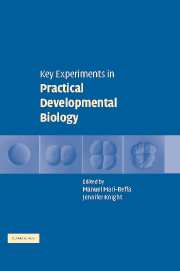Book contents
- Frontmatter
- Contents
- List of contributors
- Preface
- Introduction
- SECTION I GRAFTINGS
- 1 Two developmental gradients control head formation in hydra
- 2 Embryonic regulation and induction in sea urchin development
- 3 The isthmic organizer and brain regionalization in chick embryos
- SECTION II SPECIFIC CHEMICAL REAGENTS
- SECTION III BEAD IMPLANTATION
- SECTION IV NUCLEIC ACID INJECTIONS
- SECTION V GENETIC ANALYSIS
- SECTION VI CLONAL ANALYSIS
- SECTION VII IN SITU HYBRIDIZATION
- SECTION VIII TRANSGENIC ORGANISMS
- SECTION IX VERTEBRATE CLONING
- SECTION X CELL CULTURE
- SECTION XI EVO–DEVO STUDIES
- SECTION XII COMPUTATIONAL MODELLING
- Appendix 1 Abbreviations
- Appendix 2 Suppliers
- Index
- Plate Section
- References
1 - Two developmental gradients control head formation in hydra
Published online by Cambridge University Press: 11 August 2009
- Frontmatter
- Contents
- List of contributors
- Preface
- Introduction
- SECTION I GRAFTINGS
- 1 Two developmental gradients control head formation in hydra
- 2 Embryonic regulation and induction in sea urchin development
- 3 The isthmic organizer and brain regionalization in chick embryos
- SECTION II SPECIFIC CHEMICAL REAGENTS
- SECTION III BEAD IMPLANTATION
- SECTION IV NUCLEIC ACID INJECTIONS
- SECTION V GENETIC ANALYSIS
- SECTION VI CLONAL ANALYSIS
- SECTION VII IN SITU HYBRIDIZATION
- SECTION VIII TRANSGENIC ORGANISMS
- SECTION IX VERTEBRATE CLONING
- SECTION X CELL CULTURE
- SECTION XI EVO–DEVO STUDIES
- SECTION XII COMPUTATIONAL MODELLING
- Appendix 1 Abbreviations
- Appendix 2 Suppliers
- Index
- Plate Section
- References
Summary
OBJECTIVE OF THE EXPERIMENT Two developmental gradients are involved in the axial patterning of the head and the body column of a hydra. One is a morphogenetic gradient of head activation [= head formation capacity], and the other is a gradient of head inhibition. The objective of the experiment is to demonstrate the presence of these two gradients in the body column of adult hydra using transplantation experiments.
DEGREE OF DIFFICULTY The experiments involve the isolation of a piece of the body column and transplantation to the body column of a second animal. Although this appears difficult at first sight, with a little practice, almost all students learn to carry out these grafts at the rate of 6–10 successful grafts/hour.
INTRODUCTION
In animals, the developmental processes associated with axial patterning occur during early stages of embryogenesis. One example involves the processes governing head formation at the anterior end and tail formation at the posterior end of the anterior–posterior axis. In hydra, a primitive metazoan, this type of axial patterning occurs not only during embryogenesis, but also in the adult. This is due to the tissue dynamics of an adult hydra.
As shown in Figure 1.1a, a hydra has the shape of a cylindrical shell. Along the single axis are the head, body column and foot. The head at the apical end consists of a mouth region, the hypostome, and beneath that the tentacle zone, from which tentacles emerge.
- Type
- Chapter
- Information
- Key Experiments in Practical Developmental Biology , pp. 4 - 22Publisher: Cambridge University PressPrint publication year: 2005



